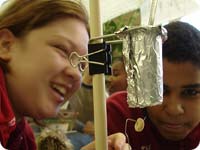CONTACT: John Stumbos, UC Davis College of Agricultural and Environmental Sciences, (530) 754-4979, jdstumbos@ucdavis.edu
Eight teams of researchers, educators and students from the University of California and California State University have received funding for projects to produce rapid results on topics as diverse as North Coast job development, improved irrigation practices for the San Joaquin Valley, and new technology to detect, monitor and treat mastitis in dairy cows.
The eight projects, selected from 44 proposals, address high-priority issues in agriculture, natural resources, and human sciences. They are also intended to foster collaboration among California's colleges and universities. Funding for the eight projects totaled $79,000 and is provided by UC's Division of Agriculture and Natural Resources.
"These projects reflect the collaborative spirit in the UC and CSU systems and the commitment the faculty share in addressing issues of importance to Californians," said Neal Van Alfen, dean of the College of Agricultural and Environmental Sciences at UC Davis. "We developed this competitive grants program to leverage scarce resources for innovative research and to provide hands-on educational experiences for our students."
The campuses involved are those with primary responsibility for agricultural and natural resources research and education in the state: UC Davis, UC Berkeley, UC Riverside, and California State University campuses at Chico, Fresno, Humboldt, Pomona, and San Luis Obispo. The grants program, now in its second year, was designed by deans and department chairs in 2009. The awarded projects, with principal investigators, are listed below:
- Assessing technology literacy skills of minority college students – Researchers from UC Riverside and Cal Poly, Pomona will assess the extent of an information technology "literacy gap" in Hispanic and other minority college students to improve student success in higher education. (Raheja , Senanayake)
- Giant sequoia growth response to disturbance intensity – Forestry scientists from UC Berkeley and Cal Poly, San Luis Obispo will measure growth response to low, medium and high levels of disturbance (e.g., fire) to better inform managers of giant sequoia groves and to provide a unique learning opportunity for UC and CSU students (York, Sink)
- Developing a collaborative environment and community research on California’s North Coast – Researchers from Humboldt State University, UC Davis, and UC Berkeley will hold a three-day workshop in Orleans, Calif. to formulate a strategic plan for natural resource management and job development with the involvement of tribes, community organizations, and schools. (Everett, Sherman, Baker, Ballard, Romm)
- Student research internship program in nutrition – Two faculty members and two undergraduate students from Cal Poly, San Luis Obispo will participate in a 10-week nutrition internship with faculty from the Western Human Nutrition Research Center at UC Davis in summer 2011 (Reaves, Loan)
- Comparing subsurface drip and overhead mechanized irrigation systems – Researchers from Fresno State University, UC Davis and the UC Kearney Agricultural Research & Extension Center in Parlier will compare water use efficiency, weed management, and profitability of flat-planted minimum tillage cropping systems using subsurface drip and overhead mechanized irrigation systems. (Shrestha, Mitchell)
- Fecundity of navel orangeworm reared from pistachio, walnut and almond hosts – Entomologists from Chico State University and UC Davis will document the reproduction of navel orangeworm a severe insect pest of almonds, pistachios, and walnuts – in field and laboratory investigations to enhance integrated pest management recommendations for growers. (Boyd, Zalom)
- New technologies for detection, monitoring and treatment of mastitis in dairy cows – Scientists and students from Cal Poly, Pomona will team with UC Cooperative Extension in San Bernardino County, and with an industry partner to investigate the use of infrared thermography for early detection and monitoring, and pulsed electromagnetic field therapy for treatment of mastitis in dairy cows. (Murinda, Peterson, Siegel)
- Factors influencing probiotic survival in ice cream – Food scientists at UC Davis and Cal Poly, San Luis Obispo will study factors affecting the shelf life of probiotics in full-fat ice cream and determine what factors affect probiotic survival in simulated gastric digestion. (Singh, Lammert)
DeeDee Kitterman, UC Davis College of Agricultural and Environmental Sciences, (530) 752-9484, dmkitterman@ucdavis.edu

 Print This
Print This 





 Filmed over the course of one year, the film follows two eleven-year-old multi-racial city kids as they explore their place in the food chain. Sadie and Safiyah take a close look at food systems in New York City and its surrounding areas. With the camera as their companion, the girl guides talk to each other, food activists, farmers, new friends, storekeepers, their families, and the viewer, in their quest to understand what’s on all of our plates.
Filmed over the course of one year, the film follows two eleven-year-old multi-racial city kids as they explore their place in the food chain. Sadie and Safiyah take a close look at food systems in New York City and its surrounding areas. With the camera as their companion, the girl guides talk to each other, food activists, farmers, new friends, storekeepers, their families, and the viewer, in their quest to understand what’s on all of our plates. The girls address questions regarding the origin of the food they eat, how it’s cultivated, how many miles it travels from the harvest to their plate, how it’s prepared, who prepares it, and what is done afterwards with the packaging and leftovers. They visit the usual supermarkets, fast food chains, and school lunchrooms. But they also check into innovative sustainable food system practices by going to farms, greenmarkets, and community supported agriculture programs. They discover that these programs both help struggling farmers to survive on the one hand and provide affordable, locally-grown food to communities on the consumer end, especially to lower-income urban families. In WHAT’S ON YOUR PLATE?, the two friends formulate sophisticated and compassionate opinions on the state of their society, and by doing so inspire hope and active engagement in others.
The girls address questions regarding the origin of the food they eat, how it’s cultivated, how many miles it travels from the harvest to their plate, how it’s prepared, who prepares it, and what is done afterwards with the packaging and leftovers. They visit the usual supermarkets, fast food chains, and school lunchrooms. But they also check into innovative sustainable food system practices by going to farms, greenmarkets, and community supported agriculture programs. They discover that these programs both help struggling farmers to survive on the one hand and provide affordable, locally-grown food to communities on the consumer end, especially to lower-income urban families. In WHAT’S ON YOUR PLATE?, the two friends formulate sophisticated and compassionate opinions on the state of their society, and by doing so inspire hope and active engagement in others.
 Relationships between children and the food they eat have become more complicated and more important than ever. In a free-market system in the richest and most culturally diverse country in the world, the stakes could not be higher when it comes to who controls food production, distribution, cost, and quality. So, how do kids feel about food — accessing it, choosing what to have, preparing it and eating it — as an element of their daily lives? How do kids feel about contending with the life-threatening epidemics of childhood obesity, heart disease and diabetes that are so prevalent in their families, schools, and communities?
Relationships between children and the food they eat have become more complicated and more important than ever. In a free-market system in the richest and most culturally diverse country in the world, the stakes could not be higher when it comes to who controls food production, distribution, cost, and quality. So, how do kids feel about food — accessing it, choosing what to have, preparing it and eating it — as an element of their daily lives? How do kids feel about contending with the life-threatening epidemics of childhood obesity, heart disease and diabetes that are so prevalent in their families, schools, and communities? WHAT’S ON YOUR PLATE? shows city kids opening their lunch boxes and digging in, families unpacking groceries bought at the supermarket and at the co-op, adults who are learning with children how to take care of their food, their bodies and the environment all at the same time. Sadie and Safiyah visit restaurants supplied with locally grown food, an upstate New York carrot farmer hoping to sell his local harvest to the New York City Department of Education school lunch program, and a local CSA. The film will culminate with a delicious local meal that the girls will cook with their classmates.
WHAT’S ON YOUR PLATE? shows city kids opening their lunch boxes and digging in, families unpacking groceries bought at the supermarket and at the co-op, adults who are learning with children how to take care of their food, their bodies and the environment all at the same time. Sadie and Safiyah visit restaurants supplied with locally grown food, an upstate New York carrot farmer hoping to sell his local harvest to the New York City Department of Education school lunch program, and a local CSA. The film will culminate with a delicious local meal that the girls will cook with their classmates. When it comes to food production, children and families need much more knowledge to combat the industry’s financial interest in keeping their practices secret, with no concern for consumers or the planet. The filmmakers are committed to helping children and families of all backgrounds, classes and locations learn about where their food comes from so that they can make healthy, informed choices about what they feed their bodies. The purpose of our documentary film project is to educate, enlighten, and inspire our community, and will address health concerns, issues of class and race as they relate to food availability, questionable food production and consumption practices, and general food consciousness in terms of cultivating a taste for local food within a community.
When it comes to food production, children and families need much more knowledge to combat the industry’s financial interest in keeping their practices secret, with no concern for consumers or the planet. The filmmakers are committed to helping children and families of all backgrounds, classes and locations learn about where their food comes from so that they can make healthy, informed choices about what they feed their bodies. The purpose of our documentary film project is to educate, enlighten, and inspire our community, and will address health concerns, issues of class and race as they relate to food availability, questionable food production and consumption practices, and general food consciousness in terms of cultivating a taste for local food within a community. 